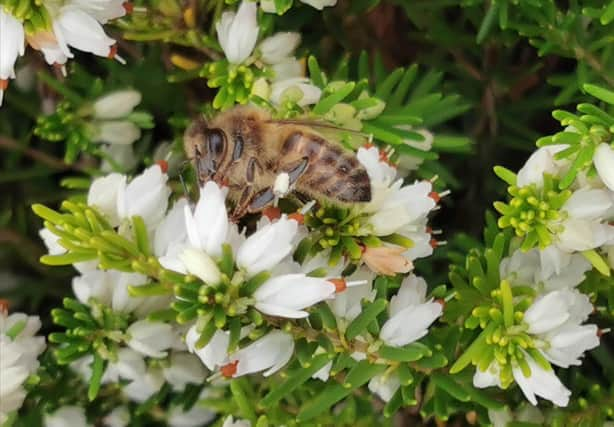GARDENING: Garden residents and visitors offer a buzz of excitement


Positively Mediterranean given what had gone before, and reason to be cheerful. But it got even better! A familiar buzz in the air but not that of a distant aircraft, rather of hive bees (Apis mellifera) mobbing the sparkling winter heathers (Erica carnea). Top notch entertainment followed. Such moments do remain in the mind's eye, but out came the smart phone anyway, down I went to ground level and numerous images were captured.
Ericas are the mainstay of our winter displays. They produce a stunning array of frost-hardy blooms from December to March, spreading growth and smothering weeds in the process, but most importantly, offering sustenance to early foraging bees. The time is right for planting these and other perennials in your garden.
Advertisement
Hide AdAdvertisement
Hide AdThere are other winter-blooming contributors of course, some shrubby in nature, others herbaceous, early bulbs too. Flowers of viburnum, prunus, mahonia, hamamelis, are playing their lofty part, whilst at ground level it`s the hellebores, ajuga, aconite and crocus that are the attraction. Collectively, they offer precious pollen and nectar at a most critical time so it's a winter win-win situation for gardeners and insects alike.
The emergence of hive bees is one of several events that bring a sense of hope and excitement as we leave a particularly dour winter behind. Garden birds are our constant reminder that survival is possible if we work as a team. We offer sustenance, they inspire and entertain. This goes beyond the varied menu renewed daily at their food station, and the water bath. Provide the natural food, roosting and nesting sites with evergreen shrubs or hedges and they`ll take up permanent residence.
Once you`ve experienced a robin or blackbird accepting food from your hand you`ll understand the spiritual reward birds bring to a garden. We are leaving grain, apples and pears out for a resident pheasant daily, thanks to last year`s bumper crop. Several species join the feast but when it's over he occasionally wanders over to the patio doors and taps loud on the glass. Is he doing an Oliver Twist or defending his territory against the image?
This past year especially, lovely ornamental plants, fruit, and vegetable crops aside, an array of precious fauna; small mammals, amphibians, birds, pollinating insects, have contributed toward a sense of calm and well-being during our confinement. Keeping them all on board is much more than a one season commitment.
Advertisement
Hide AdAdvertisement
Hide AdThe garden`s a no-go area for poisonous chemicals, thus keeping the hedgehogs and others safe as they forage amongst the vegetable beds. They are active here throughout summer, so we leave the build-up of leaf litter under a beech hedge to encourage on site hibernation. There's also a home-made wooden nesting box in there too!
A healthy frog population is at large amongst the vegetable beds during the growing season. They emanate from the small natural pond which also hosts a substantial population of newts. Some years ago, we installed a pre-formed mould, filled it with water, added a few plants then waited. The livestock, damsel flies, diving beetle et al simply appeared over time. A self-contained fountain, driven by a small solar panel, puts the icing on the cake.
The pool is a feature with year-round interest, including illegal fishing attempts by a heron whose flight path we lie on, but sitting by it on a calm summer day is tops for entertainment. The gentle trickle of the fountain, a frog croaking, newts rising to the surface as water boatmen skim back and forth. A complete eco-system.
Let's not forget big Mr Toad. He's more a greenhouse resident than pool dweller. Patrolling the tomato plant border in summer is his thing. Over winter he either digs into the border or tunnels under a stack of seed trays. Knowing this makes us cautious lest he is injured by our activities, but it's still a surprise when the soil moves!